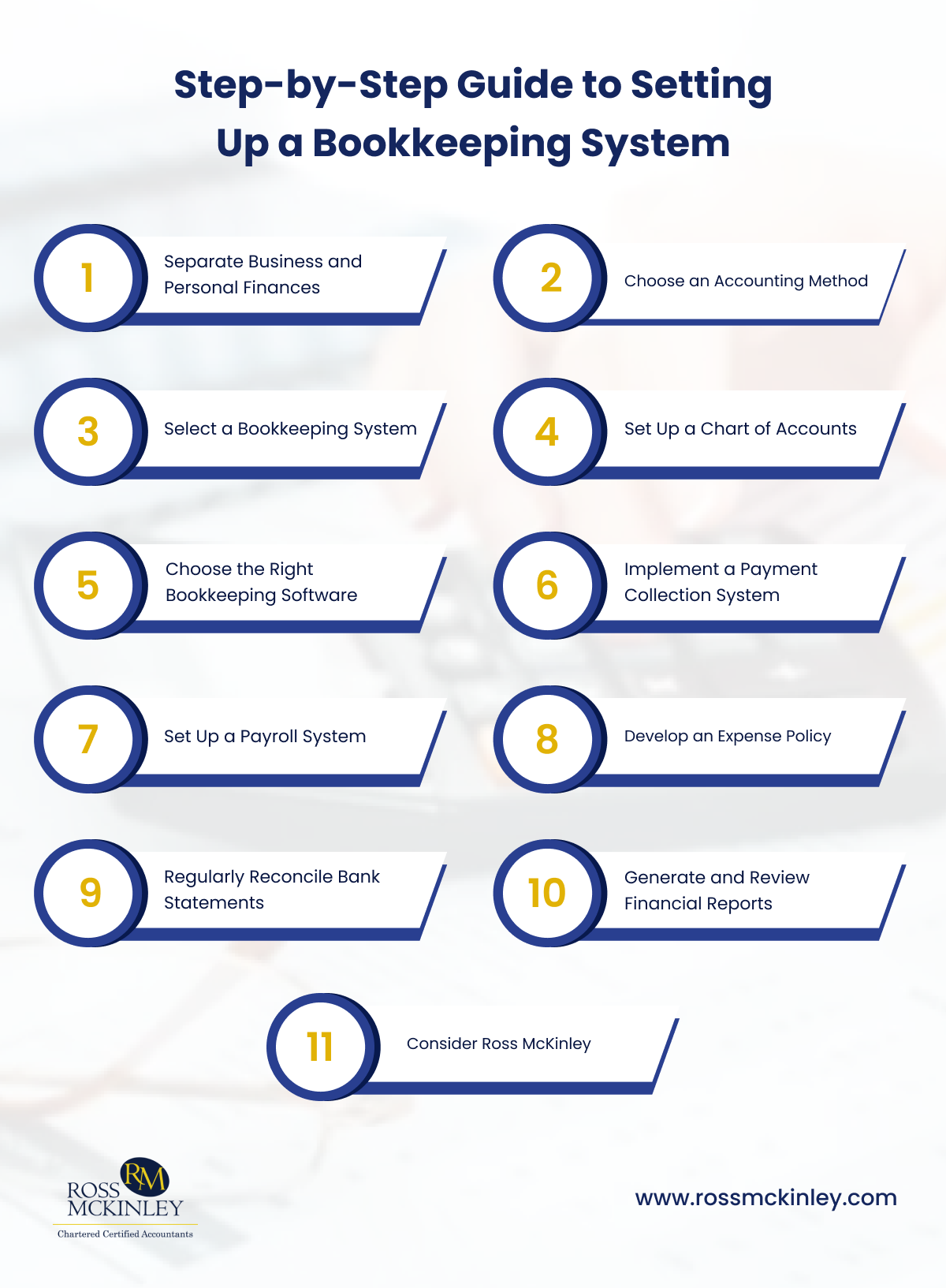
Bookkeeping Year-End Checklist
May 15, 2025
Top 10 Common Bookkeeping Mistakes and How to Avoid Them
May 17, 2025Step-by-Step Guide to Setting Up a Bookkeeping System

Embarking on the entrepreneurial journey is exhilarating, but amidst the excitement, it’s crucial not to overlook the backbone of your business: a robust bookkeeping system. Well, think of it as the GPS for your financial journey, and without it, you’re navigating blindly.
Yeah, You heard it right! So, let’s start by seeing what exactly bookkeeping is, and then, without further delay, we’ll hop into a step-by-step guide to setting up a bookkeeping system that will keep your business on the right track.

Table of Contents
What is a Bookkeeping System?
So, first things first, what exactly is a bookkeeping system? A bookkeeping system is a method a business uses to record, track, and organize its financial transactions. It’s a structure designed to manage daily financial activities like sales, purchases, receipts, and payments in an orderly and accurate way.
Bookkeepers are responsible for various financial tasks, including recording transactions, reconciling bank statements, managing accounts payable and receivable, handling payroll, and preparing preliminary financial statements. This organized approach helps businesses keep their financial affairs in order and makes tax time a lot smoother.
Role of Bookkeeping
The primary objective of bookkeeping is to ensure that financial information is up-to-date and comprehensive, providing a solid foundation for further financial analysis.
In the UK, bookkeepers may obtain certifications from professional bodies such as the Association of Accounting Technicians (AAT) or the Institute of Certified Bookkeepers (ICB), validating their field proficiency.
Step-by-Step Guide to Setting Up a Bookkeeping System
A well-organized system ensures smooth financial management, accurate records, and informed decision-making. Here’s a step-by-step guide to help you set up an efficient bookkeeping system for your business.
1. Separate Business and Personal Finances
First and foremost, open a dedicated business bank account. This separation simplifies tracking expenses and income, ensures clarity during tax season, and presents a professional image to clients and vendors.
Mixing personal and business finances can lead to confusion and potential legal complications.
2. Choose an Accounting Method: Cash vs. Accrual
Secondly, Deciding between cash and accrual accounting methods plays a pivotal role in setting up a bookkeeping system. You can choose either one of these according to your preferences.
Cash Accounting records transactions when cash changes hands. It’s straightforward and provides a real-time view of cash flow.
On the other hand, Accrual Accounting Records income and expenses when earned or incurred, regardless of when money is exchanged. This method offers a more accurate picture of long-term financial health but is more complex.
Many small businesses start with cash accounting due to its simplicity, but transitioning to accrual accounting might be beneficial as your business grows.
3. Select a Bookkeeping System
When setting up a bookkeeping system, you must choose between a single-entry or double-entry system.
The single-entry system is simple and works like balancing a checkbook, making it suitable for small businesses with minimal transactions. However, it offers limited financial tracking.
In contrast, the double-entry system is more comprehensive and commonly used by businesses of all sizes. Each transaction is recorded in at least two accounts, ensuring accurate and balanced financial records.
Though more complex, the double-entry system provides a complete view of your financial health, reduces errors, and supports detailed financial statements, making it the preferred choice for growing businesses.
4. Set Up a Chart of Accounts
Create a chart of accounts tailored to your business needs. This list categorizes all financial transactions, including assets, liabilities, income, and expenses. A well-structured chart of accounts ensures organized records and simplifies financial reporting.
Most bookkeeping software packages will set up a basic chart of accounts for you based on your entity type. But you’ll likely need to tweak this chart to match your business’s needs better. Each account should have an account name, a type, a description, and a number.
5. Choose the Right Bookkeeping Software
While it’s technically possible to manage business finances with Excel or even pen and paper, using bookkeeping software is far more practical. Daily recording transactions can be time-consuming, exhausting, and prone to errors. A simple bookkeeping software solution is affordable and can quickly pay for itself by saving time and offering more efficient financial management capabilities.
Features to consider included in your bookkeeping software are invoicing, expense tracking, payroll processing, and financial reporting. Cloud-based solutions offer accessibility and real-time updates, which benefit dynamic business environments.
6. Implement a Payment Collection System
Establish a reliable system for invoicing and receiving payments. Timely invoicing and efficient payment processing are vital for maintaining a healthy cash flow.
A pro tip is to consider integrating payment gateways such as Stripe or PayPal that offer clients multiple payment options, enhancing convenience and promptness.
7. Set Up a Payroll System
If you have employees, a structured payroll system is essential. It ensures timely and accurate compensation, complies with tax regulations, and organizes employee records.
In addition to ensuring that employees receive accurate and timely paychecks, employers must also complete several payroll-related tasks, including
- Verifying employee eligibility to work in the UK.
- Calculating and withholding payroll tax.
- Registering for payroll tax.
- Filing employment tax forms.
8. Develop an Expense Policy
Establish clear guidelines for business expenses. Define what constitutes a business expense, set spending limits, and outline reimbursement procedures.
A well-communicated expense policy helps control costs and ensures consistency in financial practices.
9. Regularly Reconcile Bank Statements
Monthly reconciliation of your bank statements with your bookkeeping records is crucial. This practice identifies discrepancies, prevents fraud, and ensures the accuracy of your financial data.
Timely reconciliations contribute to reliable financial reporting and informed decision-making.
10. Generate and Review Financial Reports
Generating and reviewing key financial reports is crucial for understanding the financial health of your business. Key documents like the income statement, balance sheet, and cash flow statement provide valuable insights.
The income statement reveals the business’s profitability over time, helping you track how much money the business is making or losing.
On the other hand, The balance sheet offers a snapshot of your company’s assets, liabilities, and equity, allowing you to assess its financial position.
Lastly, the cash flow statement is essential for understanding how cash moves in and out of your business, ensuring liquidity, and identifying potential cash flow problems. Regularly reviewing these reports allows you to make informed decisions.
11. Consider Ross McKinley
As your business expands, managing finances can become more intricate. Hiring a professional bookkeeper or accountant ensures compliance with tax laws, provides valuable financial insights, and allows you to focus on growing your business.
When finding reliable, professional help, look no other than Ross McKinley. We offer expert accounting services to support your business at every stage, from bookkeeping to strategic financial planning.
Conclusion
Setting up a bookkeeping system may seem daunting, but by breaking it down into these manageable steps, you can establish a solid financial foundation for your business.
Consistency is key, and Ross McKinley ensures you’re never left behind. Regularly updating your books, reviewing financial reports, and staying informed about financial best practices will keep your business financially healthy and poised for growth.
And when in doubt, don’t hesitate to dive into our DMs to navigate the complexities of business finances.
